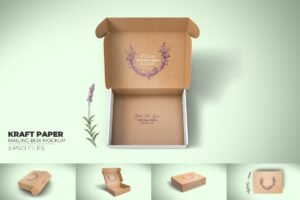The significance of material choice in custom perfume box design
The choice of materials for custom perfume boxes is of paramount importance as it directly influences the overall perception and appeal of the product. A well-chosen material not only protects the precious fragrance within but also serves as a powerful marketing tool, communicating the brand’s image, quality, and value to the discerning consumer.

The material sets the tone for the unboxing experience, creating a sensory connection before the perfume is even smelled. It can convey a sense of luxury, elegance, or modernity, aligning with the brand’s positioning and target audience. Moreover, the right material ensures the durability and integrity of the packaging, safeguarding the perfume from damage during storage and transportation.
Paper and Cardboard Options
A. Kraft paper
Kraft paper is a popular choice for custom perfume boxes due to its distinct characteristics and numerous benefits. It has a natural, earthy look and feel that gives a rustic and organic charm. Its coarse texture adds a tactile element, making the packaging more engaging.
The benefits of kraft paper are aplenty. It is eco-friendly, biodegradable, and recyclable, appealing to environmentally conscious consumers. It is also relatively inexpensive, making it a cost-effective option without compromising on quality.
In terms of suitability for certain perfume styles, kraft paper works well for fragrances with a natural, botanical, or earthy theme. It pairs perfectly with perfumes that aim to evoke a sense of purity and simplicity.
B. Coated paperboard
Coated paperboard offers a smooth and polished surface, thanks to the various coatings available. These coatings can range from gloss to matte, each imparting a different effect.
A gloss coating provides a high-shine finish, making colors appear more vibrant and enhancing the visual impact. It is ideal for creating a bold and glamorous look, suitable for perfumes with a sophisticated and glamorous image.
A matte coating, on the other hand, offers a more subdued and elegant appearance. It gives a sophisticated touch, making it suitable for classic and timeless fragrances.
The advantage of coated paperboard lies in its excellent printability. Fine details, intricate patterns, and rich colors can be reproduced with precision, allowing for highly customizable and visually stunning packaging.
Plastic Materials
A. Clear plastic (PET, PVC)
Clear plastic, such as PET (Polyethylene Terephthalate) and PVC (Polyvinyl Chloride), offers excellent visibility and product display. The transparency allows the perfume bottle to be showcased, catching the customer’s eye and creating an immediate visual connection.
This visibility is especially useful for perfumes with an aesthetically pleasing bottle design or unique color. It can also highlight any special features or decorations of the bottle.
In terms of use cases and considerations, clear plastic is often used for limited edition or special collection perfumes where the focus is on presenting the bottle as a piece of art. However, it is important to ensure the quality of the plastic to avoid scratches or cloudiness that could detract from the overall appearance.
B. Rigid plastic
Rigid plastic provides durability and protection for the perfume. It is resistant to impact and pressure, ensuring the contents remain safe.
The aesthetic appeal of rigid plastic lies in its ability to be molded into various shapes and designs. It can offer sleek and modern looks, or be textured to add depth and interest.
This material is suitable for perfumes that target a younger, trend-conscious audience or for travel-sized versions where durability is crucial.
Metal Materials
A. Aluminum
Aluminum is lightweight yet sturdy, making it a practical choice for perfume boxes. It is easy to handle and transport without adding significant weight.
The finish options for aluminum are diverse. It can be anodized to create a range of colors and finishes, from matte to shiny. This allows for branding potential, as the logo or brand name can be etched or printed onto the surface with precision.
Aluminum is often chosen for perfumes that aim for a contemporary and sleek image, or for brands that want to convey a sense of innovation and technology.
B. Stainless steel
Stainless steel gives a premium look and feel. Its polished surface exudes luxury and sophistication.
It is known for its longevity and recyclability, making it an environmentally friendly choice. The durability of stainless steel ensures that the packaging remains in pristine condition over time.
This material is ideal for high-end, prestige perfumes where the brand wants to communicate exclusivity and quality.
Fabric and Textile Materials
A. Satin
Satin offers a soft touch and an air of elegance. The smooth and lustrous surface adds a sensual element to the packaging.
The customization possibilities with satin are vast. It can be dyed in various colors, embroidered, or printed with patterns and logos.
Satin is suitable for perfumes that target a feminine and romantic audience, or for special occasion fragrances.
B. Velvet
Velvet creates a luxury impression. Its plush texture evokes opulence and indulgence.
It is often used for high-end perfumes, especially those with a rich and complex scent profile. The fabric enhances the overall sensory experience of the unboxing.
Conclusion
The best materials for custom perfume boxes depend on various factors such as the brand image, perfume style, target audience, and budget. Paper and cardboard options offer versatility and cost-effectiveness, while plastic materials provide visibility and durability.





